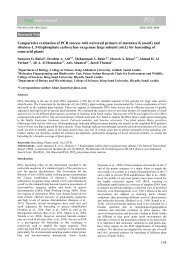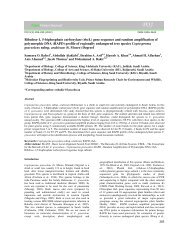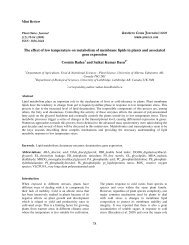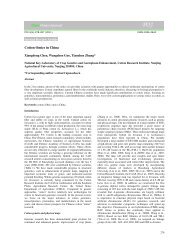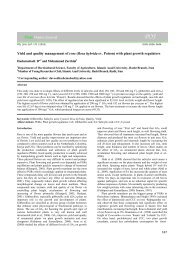Potential of Molecular Markers in Plant Biotechnology - ResearchGate
Potential of Molecular Markers in Plant Biotechnology - ResearchGate
Potential of Molecular Markers in Plant Biotechnology - ResearchGate
Create successful ePaper yourself
Turn your PDF publications into a flip-book with our unique Google optimized e-Paper software.
Review article<br />
Disadvantages: Disadvantages <strong>in</strong>clude low genome<br />
coverage and low levels <strong>of</strong> variation below the<br />
species level. In the event that primers for a genomic<br />
region <strong>of</strong> <strong>in</strong>terest are unavailable, high development<br />
costs are <strong>in</strong>volved. If sequences are visualized by<br />
polyacrylamide gel electrophoresis and autoradiography,<br />
analytical procedures are laborious and<br />
technically demand<strong>in</strong>g. Fluorescent detection systems<br />
and reliable analytical s<strong>of</strong>tware to score base pairs<br />
us<strong>in</strong>g automated sequencers are now widely applied.<br />
This requires considerable <strong>in</strong>vestments for equipment<br />
or substantial costs <strong>in</strong> the case <strong>of</strong> outsourc<strong>in</strong>g.<br />
Because sequenc<strong>in</strong>g is costly and time-consum<strong>in</strong>g,<br />
most studies have focused on only one or a few loci.<br />
This restricts genome coverage and together with the<br />
fact that different genes may evolve at different rates,<br />
the extent to which the estimated gene diversity<br />
reflects overall genetic diversity is yet to be<br />
determ<strong>in</strong>ed.<br />
Applications: In general, <strong>in</strong>sufficient nucleotide<br />
variation is detected below the species level, and PCR<br />
sequenc<strong>in</strong>g is most useful to address questions <strong>of</strong><br />
<strong>in</strong>terspecific and <strong>in</strong>tergeneric relationships (Sanger et<br />
al. 1977, Clegg 1993a). Until recently, chloroplast<br />
DNA and nuclear ribosomal DNA have provided the<br />
major datasets for phylogenetic <strong>in</strong>ference because <strong>of</strong><br />
the ease <strong>of</strong> obta<strong>in</strong><strong>in</strong>g data due to high copy number.<br />
Recently, s<strong>in</strong>gle- to low-copy nuclear DNA markers<br />
have been developed as powerful new tools for<br />
phylogenetic analyses (Mort & Crawford 2004, Small<br />
et al. 2004). Low-copy nuclear markers generally<br />
circumvent problems <strong>of</strong> uniparental <strong>in</strong>heritance<br />
frequently found <strong>in</strong> plastid markers (Corriveau &<br />
Coleman1988) and concerted evolution found <strong>in</strong><br />
nuclear ribosomal DNA (Arnheim1983) that limits<br />
their utility and reliability <strong>in</strong> phylogenetic studies<br />
(Bailey et al. 2003). In addition to biparental<br />
<strong>in</strong>heritance, low-copy nuclear markers exhibit higher<br />
rates <strong>of</strong> evolution (particularly <strong>in</strong> <strong>in</strong>tron regions) than<br />
cpDNA and nrDNA markers (Wolfe et al. 1987,<br />
Small et al. 2004) mak<strong>in</strong>g them useful for closely<br />
related species. Yet another advantage is that lowcopy<br />
sequences generally evolve <strong>in</strong>dependently <strong>of</strong><br />
paralogous sequences and tend to be stable <strong>in</strong> position<br />
and copy number.<br />
Microsatellites or Simple sequence Repeat (SSR)<br />
Introduction: The term microsatellites was co<strong>in</strong>ed<br />
by Litt & Lutty (1989)and it also known as Simple<br />
Sequence Repeats (SSRs), are sections <strong>of</strong> DNA,<br />
consist<strong>in</strong>g <strong>of</strong> tandemly repeat<strong>in</strong>g mono-, di-, tri-,<br />
tetra- or penta-nucleotide units that are arranged<br />
throughout the genomes <strong>of</strong> most eukaryotic species<br />
(Powell et al. 1996). Microsatellite markers,<br />
developed from genomic libraries, can belong to<br />
either the transcribed region or the non transcribed<br />
region <strong>of</strong> the genome, and rarely is there <strong>in</strong>formation<br />
available regard<strong>in</strong>g their functions. Microsatellite<br />
sequences are especially suited to dist<strong>in</strong>guish closely<br />
related genotypes; because <strong>of</strong> their high degree <strong>of</strong><br />
variability, they are, therefore, favoured <strong>in</strong> population<br />
studies (Smith & Devey 1994) and for the<br />
identification <strong>of</strong> closely related cultivars (Vosman et<br />
al. 1992). Microsatellite polymorphism can be<br />
detected by Southern hybridisation or PCR.<br />
Microsatellites, like m<strong>in</strong>isatellites, represent tandem<br />
repeats, but their repeat motifs are shorter (1–6 base<br />
pairs). If nucleotide sequences <strong>in</strong> the flank<strong>in</strong>g regions<br />
<strong>of</strong> the microsatellite are known, specific primers<br />
(generally 20–25 bp) can be designed to amplify the<br />
microsatellite by PCR. Microsatellites and their<br />
flank<strong>in</strong>g sequences can be identified by construct<strong>in</strong>g a<br />
small-<strong>in</strong>sert genomic library, screen<strong>in</strong>g the library<br />
with a synthetically labelled oligonucleotide repeat<br />
and sequenc<strong>in</strong>g the positive clones. Alternatively,<br />
microsatellite may be identified by screen<strong>in</strong>g<br />
sequence databases for microsatellite sequence motifs<br />
from which adjacent primers may then be designed.<br />
In addition, primers may be used that have already<br />
been designed for closely related species. Polymerase<br />
slippage dur<strong>in</strong>g DNA replication, or slipped strand<br />
mispair<strong>in</strong>g, is considered to be the ma<strong>in</strong> cause <strong>of</strong><br />
variation <strong>in</strong> the number <strong>of</strong> repeat units <strong>of</strong> a<br />
microsatellite, result<strong>in</strong>g <strong>in</strong> length polymorphisms that<br />
can be detected by gel electrophoresis. Other causes<br />
have also been reported (Matsuoka et al. 2002).<br />
Advantages: The strengths <strong>of</strong> microsatellites <strong>in</strong>clude<br />
the codom<strong>in</strong>ance <strong>of</strong> alleles, their high genomic<br />
abundance <strong>in</strong> eukaryotes and their random<br />
distribution throughout the genome, with preferential<br />
association <strong>in</strong> low-copy regions (Morgante et al.<br />
2002). Because the technique is PCR-based, only low<br />
quantities <strong>of</strong> template DNA (10–100 ng per reaction)<br />
are required. Due to the use <strong>of</strong> long PCR primers, the<br />
reproducibility <strong>of</strong> microsatellites is high and analyses<br />
do not require high quality DNA. Although<br />
microsatellite analysis is, <strong>in</strong> pr<strong>in</strong>ciple, a s<strong>in</strong>gle-locus<br />
technique, multiple microsatellites may be<br />
multiplexed dur<strong>in</strong>g PCR or gel electrophoresis if the<br />
149



